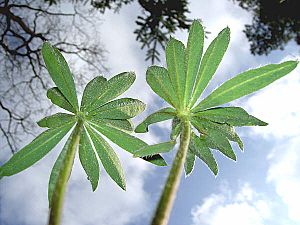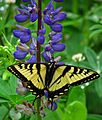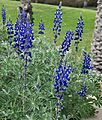Lupin facts for kids
Quick facts for kids Lupin |
|
|---|---|
 |
|
| Wild Perennial Lupin (Lupinus perennis) | |
| Scientific classification | |
| Kingdom: | |
| Division: | |
| Class: | |
| Order: | |
| Family: | |
| Subfamily: | |
| Tribe: | |
| Genus: |
Lupinus
|
| Subgenus: |
Lupinus and Platycarpos (Wats.) Kurl.
|
| Species | |
|
150-200 species, including: Lupinus albifrons |
|
Lupins are beautiful flowering plants. They are also known as lupines in North America. These plants belong to the Lupinus genus. They are part of the Fabaceae family, just like peas and beans!
There are about 150 to 200 different kinds of lupin species. You can find them growing in many parts of the world. Some lupins grow in the Mediterranean region. Others are found across the Americas.
What Lupins Look Like
Most lupins are perennial plants. This means they live for more than two years. They usually grow to be about 0.3 to 1.5 meters tall. Some types are annual plants, living for only one year. A few kinds of lupins are shrubs, growing up to 3 meters tall. There's even one special type, Lupinus jaimehintoniana, that can grow into an 8-meter-tall tree! This tree is found in Mexico.
Lupins have a very unique leaf shape. Their leaves are often soft green or silvery. They look like a hand with 5 to 17 "fingers" or leaflets. Many lupin leaves are also covered in soft, silvery hairs.
The flowers of lupins grow in tall, upright spikes. Each flower is about 1 to 2 centimeters long. They have a special shape, much like a pea flower. Each flower has an upper "standard" petal, two side "wing" petals, and two lower petals joined together to form a "keel." Lupin flowers come in many bright colors, like blue, pink, violet, and yellow.
After the flowers bloom, the plant produces a pod. This pod is like a small bean pod. It holds several seeds inside.
Lupins as an Introduced Plant
Sometimes, plants grow in places where they are not native. This can cause problems for the local environment. In New Zealand, lupins have spread widely. You can see large groups of them growing along roads and streams, especially in the South Island.
The seeds of lupins can travel easily. Car tires can carry them along roads. Water can also spread the seeds down streams. Sadly, some tourist shops have even sold lupin seeds to visitors. They told people to plant them, which helps the lupins spread even more.
Even though lupins are very pretty, with their colorful flowers against mountains and lakes, they can harm native plants. They take over areas where local plants should grow. New Zealand's environmental groups are working to reduce the number of lupins. It's a big challenge to control their spread. However, sheep can help! In fields, sheep eat the lupins, which helps keep them from spreading too much. This is why lupins are mostly found along roadsides and stream banks where sheep don't graze.
Images for kids
-
Lupinus pilosus in Tel Aviv University, Israel
-
Lupinus sp., Raspberry Island, Alaska, United States
-
Lupins at Lake Tekapo, New Zealand
-
Texas Bluebonnet, Texas, United States
See also
 In Spanish: Lupinus para niños
In Spanish: Lupinus para niños














